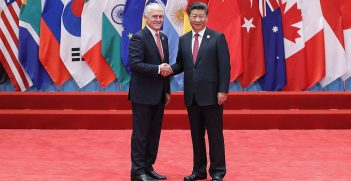Australia’s Shaky South China Sea Strategy

Principled though Australia’s commitment to freedom of navigation may be, freedom of navigation operations are not a serious roadblock to China’s bid to turn the South China Sea into a “Chinese lake”.
A BBC audio recording released earlier this week documents the Australian air force approaching the hotly contested but Chinese-controlled Mischief Reef.
Australia’s message to China was clear: ‘China navy, China navy. We are an Australian aircraft exercising international freedom of navigation rights in international airspace in accordance with the international civil aviation convention, and the United Nations Convention on the Law of the Sea. Over’.
This is a powerful and welcome demonstration of Australia’s commitment to freedom of navigation, and yet it is extremely unlikely that freedom of navigation operations (FONOPs) of this kind will modify China’s behaviour.
Although well-intentioned, Australia’s South China Sea strategy is therefore unlikely to yield significant strategic rewards.
Despite objections from some Chinese commentators that US-led and Australian-supported FONOPs in the South China Sea are a ‘flagrant and baseless provocation against China’s legitimate rights,’ the truth is that they are a comparatively weak response to strong Chinese moves to establish control over the bulk of the South China Sea.
As the nationalistic Global Times triumphantly editorialised following the 27 October transit of the USS Lassen within 12 nautical miles of a Chinese-controlled feature in the Spratly Islands, the United States has ‘no hope to win [the] South China Sea showdown.’
To be sure, FONOPs in the South China Sea touch a raw nerve given sensitivities associated with what is considered by China to be a violation of its territorial integrity. Yet the Global Times is correct when it notes that these FONOPs will not stop China from establishing de facto control over the South China Sea.
In geostrategic terms, foreign naval vessels sailing within 12 nautical miles of Chinese-controlled features or foreign air force aircraft transiting above Chinese outposts on artificial islands are limp countermoves to bold Chinese actions.
They will not slow the work of China’s armada of dredging vessels, which has already reclaimed more than 1,100 hectares of land in disputed waters since December 2013.
They will not dissuade China from transforming disputed features into “unsinkable aircraft carriers,” complete with runways capable of handling long-distance bombers.
And they will not impede China’s non-military maritime law enforcement vessels from asserting Chinese control over contested South China Sea waters by expelling Filipino and Vietnamese fishermen.
In short, regular FONOPs are an ineffective response to China’s so-far successful strategy of incrementally consolidating and expanding its hold over the South China Sea.
The South China Sea FONOPs program has admittedly had some impact on Chinese thinking. In response to recent US FONOPs, many moderate voices in China argued for more conciliatory South China Sea policy.
Influential Chinese Academy of Social Sciences scholar Xue Li has sought to sooth Sino-US tensions by arguing that ‘the South China Sea issue is not a core interest of either China or the United States’ and cautioning against moves and countermoves from both sides that could elevate tensions.
Meanwhile, Gao Zhiguo, head of the China Institute for Marine Affairs, has suggested establishing a South China Sea Cooperation Council to encourage security cooperation, joint development and environmental protection.
Despite this diversity of views on the South China Sea among Chinese academics, commentators and journalists, China is unlikely to soften its stance.
The Chinese Communist Party’s official line on the South China Sea remains uncompromising and unchanging. China is said to have “indisputable sovereignty” over this body of water and asserting Chinese control is considered a “core national interest”.
In Chinese President Xi Jinping’s words, the disputed islands and reefs of the South China Sea ‘were left to us by our ancestors. The Chinese people will not allow anyone to infringe on China’s sovereignty and related rights and interests’.
Accordingly, as Vice-Foreign Minister Liu Zhenmin emphasised last month, China has the “right” to seize disputed islands in the South China Sea.
None of the above is to argue that Australia should simply acquiesce to China’s claim to roughly 90 percent of one of Asia’s most strategically important and resource-rich bodies of water.
Like the United States and other regional powers, Australia has legitimate concerns about Chinese goals and activities in the South China Sea.
Australia is a stakeholder in Asia’s rules-based international order and has a strong vested interest in China and other claimant states submitting to established legal procedures to reach a peaceful and fair resolution of the South China Sea’s territorial disputes.
However, policymakers in Canberra should not harbour illusions about the chances of Australia’s South China Sea strategy actually working.
Principled though Australia’s commitment to freedom of navigation may be, FONOPs are not a serious roadblock to China’s bid to turn the South China Sea into a “Chinese lake”.
Dr Benjamin Herscovitch is a Visiting Fellow at the Charhar Institute and a Senior Analyst at Wikistrat. This article may be republished under a Creative Commons License.





